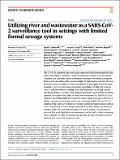Files in this item
Utilizing river and wastewater as a SARS-CoV-2 surveillance tool in settings with limited formal sewage systems
Item metadata
| dc.contributor.author | Barnes, Kayla G | |
| dc.contributor.author | Levy, Joshua I | |
| dc.contributor.author | Gauld, Jillian | |
| dc.contributor.author | Rigby, Jonathan | |
| dc.contributor.author | Kanjerwa, Oscar | |
| dc.contributor.author | Uzzell, Christopher B | |
| dc.contributor.author | Chilupsya, Chisomo | |
| dc.contributor.author | Anscombe, Catherine | |
| dc.contributor.author | Tomkins-Tinch, Christopher | |
| dc.contributor.author | Mbeti, Omar | |
| dc.contributor.author | Cairns, Edward | |
| dc.contributor.author | Thole, Herbert | |
| dc.contributor.author | McSweeney, Shannon | |
| dc.contributor.author | Chibwana, Marah G | |
| dc.contributor.author | Ashton, Philip M | |
| dc.contributor.author | Jere, Khuzwayo C | |
| dc.contributor.author | Meschke, John Scott | |
| dc.contributor.author | Diggle, Peter | |
| dc.contributor.author | Cornick, Jennifer | |
| dc.contributor.author | Chilima, Benjamin | |
| dc.contributor.author | Jambo, Kondwani | |
| dc.contributor.author | Andersen, Kristian G | |
| dc.contributor.author | Kawalazira, Gift | |
| dc.contributor.author | Paterson, Steve | |
| dc.contributor.author | Nyirenda, Tonney S | |
| dc.contributor.author | Feasey, Nicholas | |
| dc.date.accessioned | 2023-12-20T17:30:12Z | |
| dc.date.available | 2023-12-20T17:30:12Z | |
| dc.date.issued | 2023-11-30 | |
| dc.identifier | 297540511 | |
| dc.identifier | 23d3efe4-4a52-421e-9364-474166b84637 | |
| dc.identifier | 85178196403 | |
| dc.identifier.citation | Barnes , K G , Levy , J I , Gauld , J , Rigby , J , Kanjerwa , O , Uzzell , C B , Chilupsya , C , Anscombe , C , Tomkins-Tinch , C , Mbeti , O , Cairns , E , Thole , H , McSweeney , S , Chibwana , M G , Ashton , P M , Jere , K C , Meschke , J S , Diggle , P , Cornick , J , Chilima , B , Jambo , K , Andersen , K G , Kawalazira , G , Paterson , S , Nyirenda , T S & Feasey , N 2023 , ' Utilizing river and wastewater as a SARS-CoV-2 surveillance tool in settings with limited formal sewage systems ' , Nature Communications , vol. 14 , 7883 . https://doi.org/10.1038/s41467-023-43047-y | en |
| dc.identifier.issn | 2041-1723 | |
| dc.identifier.other | Jisc: 1570253 | |
| dc.identifier.other | pmid: 38036496 | |
| dc.identifier.other | pmcid: PMC10689440 | |
| dc.identifier.other | ORCID: /0000-0003-4041-1405/work/157140372 | |
| dc.identifier.uri | https://hdl.handle.net/10023/28913 | |
| dc.description | Funding: This publication is based on research funded by PATH, the Bill & Melinda Gates Foundation (grant number 583722 and OPP1155752). K.G.B. is funded by a NIH Fogarty Fellowship (K01TW010853). | en |
| dc.description.abstract | The COVID-19 pandemic has profoundly impacted health systems globally and robust surveillance has been critical for pandemic control, however not all countries can currently sustain community pathogen surveillance programs. Wastewater surveillance has proven valuable in high-income settings, but less is known about the utility of water surveillance of pathogens in low-income countries. Here we show how wastewater surveillance of SAR-CoV-2 can be used to identify temporal changes and help determine circulating variants quickly. In Malawi, a country with limited community-based COVID-19 testing capacity, we explore the utility of rivers and wastewater for SARS-CoV-2 surveillance. From May 2020-May 2022, we collect water from up to 112 river or defunct wastewater treatment plant sites, detecting SARS-CoV-2 in 8.3% of samples. Peak SARS-CoV-2 detection in water samples predate peaks in clinical cases. Sequencing of water samples identified the Beta, Delta, and Omicron variants, with Delta and Omicron detected well in advance of detection in patients. Our work highlights how wastewater can be used to detect emerging waves, identify variants of concern, and provide an early warning system in settings with no formal sewage systems. | |
| dc.format.extent | 11 | |
| dc.format.extent | 2231394 | |
| dc.language.iso | eng | |
| dc.relation.ispartof | Nature Communications | en |
| dc.subject | Humans | en |
| dc.subject | Water | en |
| dc.subject | Rivers | en |
| dc.subject | Sewage | en |
| dc.subject | Pandemics | en |
| dc.subject | Wastewater-based epidemiological monitoring | en |
| dc.subject | COVID-19 | en |
| dc.subject | SARS-CoV-2 | en |
| dc.subject | COVID-19 testing | en |
| dc.subject | Wastewater | en |
| dc.subject | RA0421 Public health. Hygiene. Preventive Medicine | en |
| dc.subject | DAS | en |
| dc.subject | SDG 3 - Good Health and Well-being | en |
| dc.subject.lcc | RA0421 | en |
| dc.title | Utilizing river and wastewater as a SARS-CoV-2 surveillance tool in settings with limited formal sewage systems | en |
| dc.type | Journal article | en |
| dc.contributor.institution | University of St Andrews. School of Medicine | en |
| dc.identifier.doi | https://doi.org/10.1038/s41467-023-43047-y | |
| dc.description.status | Peer reviewed | en |
This item appears in the following Collection(s)
Items in the St Andrews Research Repository are protected by copyright, with all rights reserved, unless otherwise indicated.

